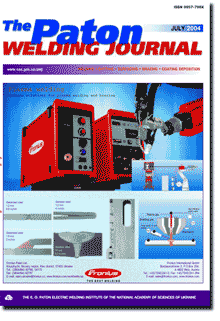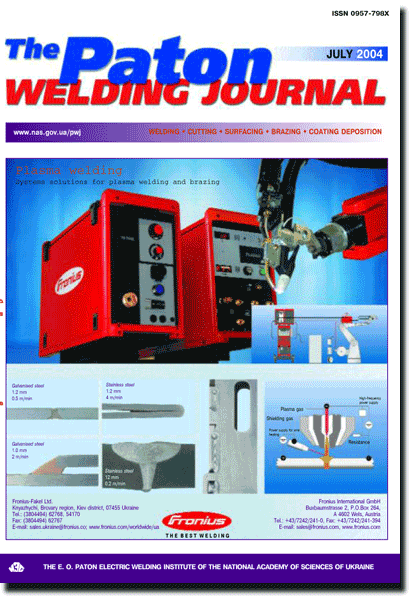

| SCIENTIFIC AND TECHNICAL | |
| Makhnenko V.I., Gajvoronsky A.A., Sarzhevsky V.A., Velikoivanenko E.A., Rozynka G.F. and Pivtorak N.I. Stresses in surfacing of parts made from high-carbon steels of the 65G type and risk of cold cracking. | 2 |
| Conditions of formation of stresses in arc surfacing of high-carbon steel plates are considered from the standpoint of different-orientation cold cracking. It is shown that formation of longitudinal cracks is caused in a number of cases by the presence of peaks of temporary stresses induced by martensitic transformation of austenite. | |
| Maksimov S.Yu. and Gurzhy A.A. Modeling the conditions of pore initiation in the weld metal in wet underwater welding. | 7 |
| Principles of evolution of gas bubbles ahead of the solidification front in wet underwater welding have been investigated using mathematical modeling. Dependence of the effect of solidification rate, hydrostatic pressure and hydrogen concentration on critical radius of a gas bubble and dynamics of its variation have been studied on the basis of the results of the numerical experiment. | |
| Yushchenko K.A., Savchenko V.S. and Zvyagintseva A.V. Effect of heat treatment and degree of alloying on structural changes in nickel alloys. | 12 |
| Alloys with a different content of gВ-forming elements have been studied. High-temperature ductility of heat-resistant nickel alloys with a different content of gВ-forming elements after heat treatment at a different cooling rate has been evaluated. It has been established that heat treatment allowing to control growth of the gВ-phase is indicated only for alloys with a high degree of alloying. | |
| Grabin V.F., Golovko V.V., Kostin V.A. and Alekseenko I.I. Morphological peculiarities of microstructure of weld metal from low-alloy steels with ultralow content of carbon. | 15 |
| It is shown that in addition to the ordinary structures characteristic of welds hardened due to presence of pearlitic structures, welds with an ultralow carbon content also develop various ferrite morphologies, including an unusual form of laminar Widmanstatten ferrite, as well as massive forms of ferrite which solidify in the form of dendrite or as a «conglomerate» of round-shaped crystallites, separated from each other by boundary precipitations of MAC-phase, forming at the final stages of residual austenite decomposition. It is noted that to decrease the carbon liquation into weld metal its silicon content should not be higher than 0.3 wt.%. | |
| Korobov Yu.S. Estimation of forces affecting the spray metal in electric arc metallising. | 21 |
| INDUSTRIAL | |
| Voropaj N.M. Specifics of arc spot shielded-gas welding processes (Review). | 26 |
| Peculiarities of processes of arc spot consumable and non-consumable electrode welding of carbon and alloyed steels, non-ferrous metals and alloys are considered. Parameters of welding in active and inert gases and also the mechanical properties of overlap joints made by the given method are presented. Prospects of development of arc spot welding technology are outlined. | |
| Kovalenko V.S. and Kolpakov V.V. Use of web-technologies to improve the competitiveness of Ukrainian engineering plants. | 32 |
| Technical solutions intended to increase the competitiveness of engineering plants through reduction of the production time, centralization of manufacturing and distribution of orders using web-technologies have been identified. Main principles of development of a web-site as an acceptor of orders have been considered, and versions of software implementation of a central server and acceptable versions of transfer, reception and performance of a product manufacturing order have been analyzed by considering the example of the server of the Laser Technology Institute of the National Technical University of Ukraine «Kiev Polytechnic Institute». The need to promptly set up a centralized web-structure to control orders of small and medium-sized engineering plants of Ukraine for raising their foreign competitiveness is proved. | |
| BRIEF INFORMATION | |
| Zadorozhny Yu.G. and Zorin M.I. Evaluation of mechanical strength of a welded piezotransducer. | 39 |
| A procedure is proposed for evaluation of mechanical strength of welded metal-piezoceramic bimorph by the size of fracture surface in peizoceramics. Dependencies of the strength of a welded metal-piezoceramic structure on welding modes are given. A welding mode is established, providing the required level of welded structure quality. | |
(You are viewing the simplified file contents)
The cost of subscription/purchase order journals or individual articles
| Journal/Currency | Annual Set | 1 issue printed |
1 issue |
one article |
| TPWJ/USD | 384 $ | 32 $ | 26 $ | 13 $ |
| TPWJ/EUR | 348 € | 29 € | 24 € | 12 € |
| TPWJ/UAH | 7200 UAH | 600 UAH | 600 UAH | 280 UAH |
| AS/UAH | 1800 UAH | 300 UAH | 300 UAH | 150 UAH |
| AS/USD | 192 $ | 32 $ | 26 $ | 13 $ |
| AS/EUR | 180 € | 30 € | 25 € | 12 € |
| SEM/UAH | 1200 UAH | 300 UAH | 300 UAH | 150 UAH |
| SEM/USD | 128 $ | 32 $ | 26 $ | 13 $ |
| SEM/EUR | 120 € | 30 € | 25 € | 12 € |
| TDNK/UAH | 1200 UAH | 300 UAH | 300 UAH | 150 UAH |
| TDNK/USD | 128 $ | 32 $ | 26 $ | 13 $ |
| TDNK/EUR | 120 € | 30 € | 25 € | 15 € |
AS = «Automatic Welding» - 6 issues per year;
TPWJ = «PATON WELDING JOURNAL» - 12 issues per year;
SEM = «Electrometallurgy Today» - 4 issues per year;
TDNK = «Technical Diagnostics and Non-Destructive Testing» - 4 issues per year.


